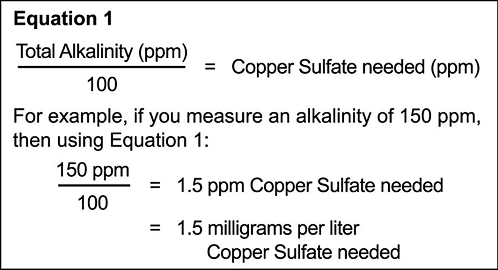

 |
||||||||||||
 |
||||||||||||
| Use of Copper in Freshwater Aquaculture and Farm Ponds | ||||||
| Craig Watson and Roy P.E. Yanong | August 30, 2002 | |||||
Introduction Copper has been used for many years as a chemical tool in freshwater farm ponds and aquaculture operations. It is both an effective algicide and a parasite treatment. The problem with the use of copper is that there is a thin line that separates effective treatment levels from overdoses, which can kill fish. This fact sheet is designed to explain when copper is used, how it is used, and some precautions to take before using it. Copper can be used to control algae in ponds, including filamentous and higher algae such as Chara ("Stink weed"). There have been some efforts to use copper to reduce the abundance of algae that cause off-flavor in catfish, but not enough is known yet to make any definite recommendations. Copper will also control most external parasites of fish, including "Ich" [see UF/IFAS Extension Circular 716, Introduction to Freshwater Fish Parasites and UF/IFAS Extension Circular 920 Ichthyophthirius multifiliis (White Spot) Infections in Fish]. Copper comes in several forms which can be used in water. The cheapest and most commonly used form is copper sulfate, which is available either as a crystal or a powder (often known as "Bluestone" or "Blue powder"). Copper sulfate is water soluble, and dissolves fairly easily when mixed with water. Several companies market copper in liquid and crystal forms. Before you use any form of copper treatment, you need to measure the total alkalinity of your water (NOT HARDNESS OR pH), since the toxicity of copper to fish increases as the total alkalinity decreases. A good rule of thumb is to divide the total alkalinity (in parts per million) by 100 to get the concentration of copper sulfate to use in parts per million (1 ppm = 1 milligram/liter) (see Equation 1 ). 
Figure 1 If the total alkalinity is less than 50 ppm, copper treatments are not recommended because of the high risk of killing fish. If the total alkalinity is over 250 ppm, do not use more than 2.5 ppm of copper sulfate. Florida's waters are extremely variable in alkalinity, so if you don't know the alkalinity of your water, find out before you treat with copper. In the literature you will see many different values for copper dosages, but experience has shown that the above formula is best for determining the dosage rate. To use copper sulfate, it should be first dissolved in water. After weighing the amount of copper sulfate needed to treat the volume of your water, mix it in water, making sure that it all dissolves. Copper sulfate is much heavier than water, and if you just throw the crystals or powder into the pond, it will sink to the bottom where pond muds will chemically bind with it, locking it up. It is recommended that you dilute the copper sulfate as much as possible and take great care when distributing it, avoiding the creation of areas with higher concentrations, commonly known as "hot spots." When using a commercially formulated copper, follow the label instructions for dosage rates. The liquid forms can be applied directly to the water, but it is recommended that they are first mixed with water to dilute them. As with copper sulfate, great care should be taken to evenly disperse commercial formulations over the entire pond area, avoiding the creation of hot spots. more ... |
 |
|||||
| About Us :: Message Board :: Chat | |||||
| Library :: Photo Gallery :: Links & Resources :: Breeders & Sponsors :: Merchandise | |||||
| Website designed by: EthanCote.com | © 2001-2004, SimplyDiscus.com. All Rights Reserved. | ||||